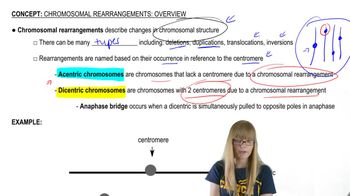How can ancient DNA provide insight into past migrations that analyses of extant human genomes fail to uncover?
Table of contents
- 1. Introduction to Genetics51m
- 2. Mendel's Laws of Inheritance3h 37m
- 3. Extensions to Mendelian Inheritance2h 41m
- 4. Genetic Mapping and Linkage2h 28m
- 5. Genetics of Bacteria and Viruses1h 21m
- 6. Chromosomal Variation1h 48m
- 7. DNA and Chromosome Structure56m
- 8. DNA Replication1h 10m
- 9. Mitosis and Meiosis1h 34m
- 10. Transcription1h 0m
- 11. Translation58m
- 12. Gene Regulation in Prokaryotes1h 19m
- 13. Gene Regulation in Eukaryotes44m
- 14. Genetic Control of Development44m
- 15. Genomes and Genomics1h 50m
- 16. Transposable Elements47m
- 17. Mutation, Repair, and Recombination1h 6m
- 18. Molecular Genetic Tools19m
- 19. Cancer Genetics29m
- 20. Quantitative Genetics1h 26m
- 21. Population Genetics50m
- 22. Evolutionary Genetics29m
22. Evolutionary Genetics
Phylogenetic Trees
Problem D.13
Textbook Question
When the human genome is examined, the chromosomes appear to have undergone only minimal rearrangement in the 100 million years since the last common ancestor of eutherian mammals. However, when individual humans are examined or when the human genome is compared with that of chimpanzees, a large number of small indels and SNPs can be detected. How are these observations reconciled?
 Verified step by step guidance
Verified step by step guidance1
Understand the difference between large-scale chromosomal rearrangements and small-scale genetic variations. Large-scale rearrangements involve major changes like inversions, translocations, or fusions of chromosome segments, while small-scale variations include single nucleotide polymorphisms (SNPs) and small insertions or deletions (indels).
Recognize that the observation of minimal chromosomal rearrangement over 100 million years refers to the overall structure and organization of chromosomes remaining largely conserved among eutherian mammals, indicating evolutionary stability at the macro level.
Acknowledge that within species (such as individual humans) or between closely related species (like humans and chimpanzees), genetic diversity arises primarily through small-scale mutations such as SNPs and indels, which accumulate more rapidly and contribute to genetic variation without altering chromosome structure significantly.
Explain that these small-scale mutations can occur frequently and are responsible for genetic differences observed within populations and between closely related species, while the large-scale chromosomal architecture remains stable over much longer evolutionary timescales.
Conclude that the reconciliation lies in the different scales and types of genetic changes: chromosome structure is conserved over millions of years, but small mutations accumulate continuously, leading to detectable genetic variation among individuals and closely related species.
 Verified video answer for a similar problem:
Verified video answer for a similar problem:This video solution was recommended by our tutors as helpful for the problem above
Video duration:
2mPlay a video:
Was this helpful?
Key Concepts
Here are the essential concepts you must grasp in order to answer the question correctly.
Chromosomal Rearrangements and Genome Stability
Chromosomal rearrangements involve large-scale changes like inversions, translocations, or fusions that alter chromosome structure. Over long evolutionary timescales, such as 100 million years, these events are relatively rare in eutherian mammals, leading to overall genome stability at the chromosomal level despite species divergence.
Recommended video:
Guided course

Rearrangement Overview
Small-scale Genetic Variations: SNPs and Indels
Single nucleotide polymorphisms (SNPs) and small insertions/deletions (indels) are minor genetic changes occurring frequently within populations and between closely related species. These variations accumulate rapidly and contribute to genetic diversity without altering large chromosomal structures.
Recommended video:
Guided course

Genomic Variation
Evolutionary Timescales and Mutation Rates
Different types of genetic changes occur at different rates; large chromosomal rearrangements happen slowly over millions of years, while small mutations like SNPs and indels accumulate quickly within populations and species. This explains why chromosomes appear stable over long periods, yet individuals and closely related species show many small genetic differences.
Recommended video:
Guided course

Mutations and Phenotypes
Related Videos
Related Practice
Textbook Question
456
views


